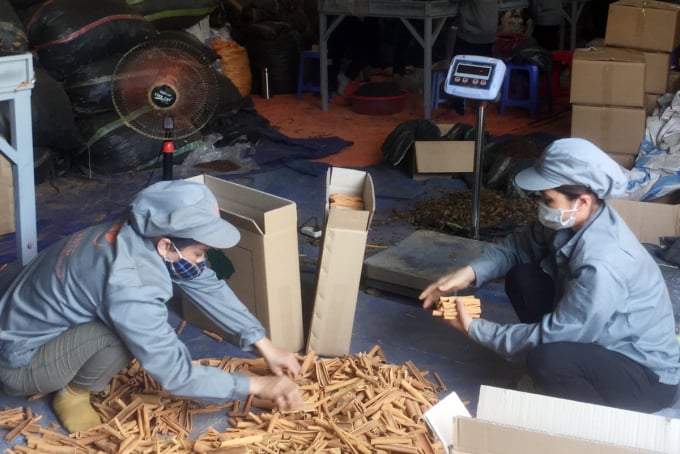November 28, 2025 | 02:12 GMT +7
November 28, 2025 | 02:12 GMT +7
Hotline: 0913.378.918
November 28, 2025 | 02:12 GMT +7
Hotline: 0913.378.918

Cinnamon flutes and split cinnamon with Lao Cai geographical indication (GI) are exported to many countries. Photo: T.N.
Mr. To Manh Tien, Deputy Director of the Department of Agriculture and Rural Development of Lao Cai province said most of the businesses that are purchasing cinnamon in Lao Cai constructed factories in Yen Bai province. And the cinnamon products for exports have Geographical Indication of Yen Bai.
Therefore, the Department of Agriculture and Rural Development of Lao Cai province has suggested the province's leaders to direct the localities to focus on building the Lao Cai cinnamon brand. In which Tam Hoi Cooperative added Lao Cai GI on cartons of cinnamon flutes and split cinnamon for exports at price of VND 120,000/kg
Exported cinnamon products with Lao Cai GI clearly show the origin of the products, helping the international markets recognize the Lao Cai's cinnamon products and at the same time increasing export value.
Currently, the localities in Lao Cai also focus on developing organic cinnamon products to meet requirements of the demanding markets but accepting higher price such as US, Japan and EU.
Lao Cai has around 3,000 hectares of organic cinnamon certificated by Control Union Certifications. Thus, the export price increases by 10-15% per kilogram compared to the conventional products.
Translated by Mai Tham

(VAN) According to Mr. Vo Minh Thanh, Director of the Tay Ninh Department of Agriculture and Environment, Resolution 57 has created a new development pathway for the locality, shifting from traditional toward modern agriculture.
/2025/11/26/4909-2-154329_878.jpg)
(VAN) Pearl grouper farming in HDPE cages not only delivers economic efficiency but also contributes to protecting the environment, creating jobs, and promoting marine-based experiential tourism.

(VAN) The model of making a living under the forest canopy through the agroforestry system in Van Son commune, Bac Ninh province, is expected to generate an annual income of approximately VND 30 million/ha.

(VAN) Many enterprises in Can Tho are harnessing natural energy and reducing greenhouse gas emissions in their production processes, thereby contributing to the promotion of a sustainable green transition.
/2025/11/24/3536-2-112800_176.jpg)
(VAN) Dong Nai now has tens of thousands of hectares of forests certified for sustainable management, and this area will continue to be expanded in the coming period.

(VAN) Vinh Ha hamlet (Dai Xuyen commune, Hanoi) is shifting away from small-scale farming as households adopt bioscurity into their breeder chicken models.

(VAN) Heavy rains make aquatic species more vulnerable to disease. Proactive water management and high-tech systems help farmers prevent outbreaks and protect yields.